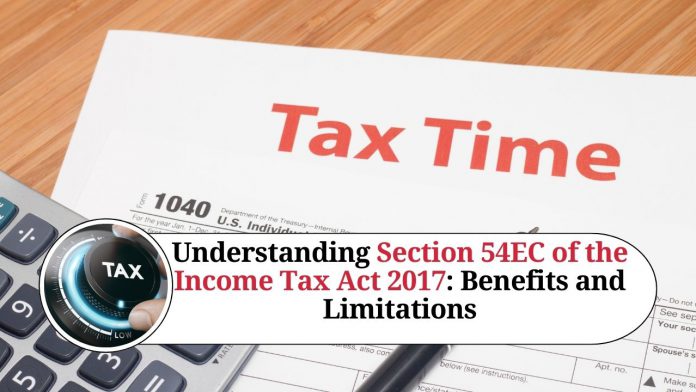The Indian government provides various incentives to promote investment in certain sectors and to encourage individuals to save and invest their money. One such incentive is provided through Section 54EC of the Income Tax Act, 2017. This section allows individuals to save tax on long-term capital gains by investing in certain specified bonds. In this blog, we will understand the benefits and limitations of Section 54EC.
What is Section 54EC of the Income Tax Act 2017?
Section 54EC of the Income Tax Act, 2017 provides tax relief to individuals who earn long-term capital gains from the sale of a capital asset. Under this section, an individual can invest the amount of long-term capital gains in specified bonds within a period of six months from the date of sale of the asset. The bonds are issued by National Highways Authority of India (NHAI) or Rural Electrification Corporation (REC) and have a lock-in period of 5 years.
Benefits of Section 54EC
- Tax Savings: One of the main benefits of Section 54EC is that it helps individuals save tax on long-term capital gains. Long-term capital gains are taxed at a rate of 20%, but by investing in the specified bonds, individuals can claim a deduction up to Rs. 50 lakhs from the taxable income of the financial year in which the bonds are subscribed. This deduction can help reduce the tax liability significantly.
- Low-risk Investment: The specified bonds issued by NHAI and REC are considered to be low-risk investments as they are backed by the government. Moreover, these bonds offer a fixed rate of interest, which is generally higher than the prevailing rate of interest offered by fixed deposits in banks.
- No Upper Limit: There is no upper limit on the amount that an individual can invest in these specified bonds. This means that an individual can invest any amount of long-term capital gains in these bonds and claim a deduction up to Rs. 50 lakhs from their taxable income.
Limitations of Section 54EC
- Lock-in period: The specified bonds have a lock-in period of 5 years. This means that an individual cannot sell the bonds or withdraw the amount invested before the completion of 5 years. If an individual withdraws the amount invested before the completion of 5 years, the tax benefits claimed earlier will be reversed.
- Limited Investment Options: Section 54EC allows investment in only NHAI or REC specified bonds. This limits the investment options available to individuals who want to claim tax benefits on long-term capital gains.
- No Exemption on Short-term Capital Gains: Section 54EC provides tax benefits only on long-term capital gains. Short-term capital gains from the sale of a capital asset are taxed at the normal rate of income tax, and there is no exemption available under this section for short-term capital gains.
Conclusion
Section 54EC of the Income Tax Act, 2017 provides a good opportunity for individuals to save tax on long-term capital gains by investing in specified bonds issued by NHAI or REC. However, it is important to understand the benefits and limitations of this section before making any investment decisions. Individuals should carefully evaluate the investment options available and consult with a financial advisor before investing in these bonds.
Read more useful content:
- section 234e of income tax act
- section 286 of income tax act
- section 90a of income tax act
- section 40a(7) of income tax act
- section 226(3) of income tax act
- section 24 of income tax act
Frequently Asked Questions (FAQs)
Q: What is Section 54EC of the Income Tax Act 2017?
A: Section 54EC of the Income Tax Act 2017 is a provision that allows individuals or Hindu Undivided Families (HUFs) to claim an exemption from capital gains tax if they invest the proceeds from the sale of a long-term asset in specified bonds issued by the Government of India.
Q: What are the assets covered under Section 54EC?
A: The assets covered under Section 54EC are long-term capital assets such as land, building, and securities, including mutual fund units, that have been held for at least two years.
Q: What is the time limit for investment under Section 54EC?
A: The time limit for investment under Section 54EC is six months from the date of transfer of the long-term capital asset.
Q: What is the maximum amount that can be invested under Section 54EC?
A: The maximum amount that can be invested under Section 54EC is Rs. 50 lakhs in a financial year.
Q: What are the specified bonds under Section 54EC?
A: The specified bonds under Section 54EC are bonds issued by the National Highways Authority of India (NHAI) and the Rural Electrification Corporation (REC).
Q: What is the lock-in period for specified bonds under Section 54EC?
A: The lock-in period for specified bonds under Section 54EC is five years from the date of acquisition.
Q: Can the specified bonds be transferred or pledged during the lock-in period?
A: No, the specified bonds cannot be transferred or pledged during the lock-in period.
Q: Can the benefit under Section 54EC be claimed multiple times?
A: Yes, the benefit under Section 54EC can be claimed multiple times, subject to a maximum investment limit of Rs. 50 lakhs per financial year.
Q: Is there any tax liability on the interest earned from specified bonds under Section 54EC?
A: Yes, the interest earned from specified bonds under Section 54EC is taxable as per the applicable income tax slab rates. However, the capital gains exemption claimed under Section 54EC will not be revoked if the interest earned is taxable.
Q: What happens if the specified bonds are sold before the lock-in period?
A: If the specified bonds are sold before the lock-in period, the capital gains exemption claimed under Section 54EC will be revoked, and the amount of exemption claimed will be added back to the total income of the individual or HUF in the year of sale of the bonds.




















